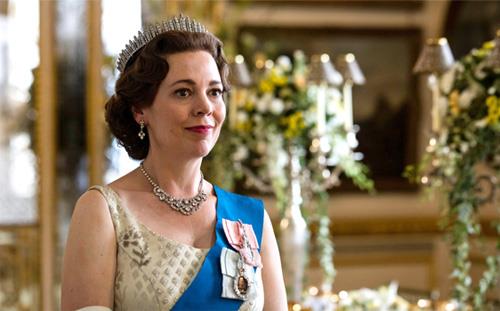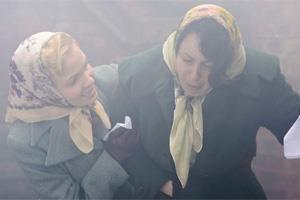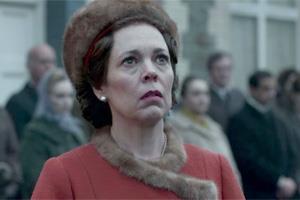
There’s nothing like a pandemic coupled with a stay-at-home order to convince one to catch up on their binge-viewing, in the somewhat vain hope that one’s Netflix watch list will become manageable.
The Crown is one of those expensive, well-received costume dramas that are all too easy to find an excuse not to watch, no matter how many Golden Globes it wins. Better Call Saul seems more topical, more current; The Handmaid’s Tale sharper, more urgent somehow.
And yet something strange and wholly unexpected happened about 20 hours into my binge. The first-season episode Act of God seemed oddly relevant to our present times — if you live in a big city with bad air, that is.
Act of God (below) documents events in December 1952 when the so-called “Great Fog of London,” aka the Big Smog, descended on the city by the Thames and killed Londoners in the thousands.
It wasn’t fog actually, but the accumulation of heavy coal smoke forced downward by a “reverse hurricane” coupled with other atmospheric conditions that prevented the smog from dissipating.
 The billowing fog banks of bad air were easy enough to see with the naked eye, but the effects — much like COVID-19 — were largely hidden from view: afflicted people had difficulty breathing, respiratory seizures, and, in the end, for many, death. It’s a gripping hour of drama, and a reflection of just how effective The Crown is as a series that an hour about a natural disaster doesn’t seem out of place in an overall story that, let’s face it, is a royal soap in fancy dress.
The billowing fog banks of bad air were easy enough to see with the naked eye, but the effects — much like COVID-19 — were largely hidden from view: afflicted people had difficulty breathing, respiratory seizures, and, in the end, for many, death. It’s a gripping hour of drama, and a reflection of just how effective The Crown is as a series that an hour about a natural disaster doesn’t seem out of place in an overall story that, let’s face it, is a royal soap in fancy dress.
There are moments of real power in Act of God, from an idealistic young woman killed by a bus as she tries to carry her dying roommate to the hospital in pea-soup-fog-like conditions, to the feeling of redemption when the smog parts after four days — a blink-of-an-eye in COVID terms — and the sun peers through, a beacon of hope and a better future, helped in no small part by a Clean Air Act being passed four years later, in 1956.
The episode is prescient, too, for not just showing how hospitals can be overwhelmed by sudden circumstances that are too big to handle, but for showing how then-Prime Minister Winston Churchill ignored warnings from scientists with Britain’s Meteorological Office that a freak weather event, coupled with London’s notoriously bad air, was a disaster waiting to happen.
Churchill, in fact, encouraged the opposite. He insisted that London keep its coal plants fired up — echoes of today — in a bid to boost the economy. Netflix streamed The Crown’s debut season in late 2016, so it’s especially eerie today, in May 2020, to hear a former prime minister, Clement Attlee, tell a querying functionary, “This is not a government…. This is a collection of hesitant, frightened old men, unable to unseat a tyrannical, delusional, even older one.”
Prescient, yes, but unsettling too.
As regular watchers of The Crown know, Netflix started streaming the third season just weeks ago. Netflix recently confirmed that there would be one more season to come, and that will be the last.
The new episodes have followed a by-now familiar pattern. Each hour-long episode revolves around a single event, with the larger story arc — Queen Elizabeth now maturing into her monarchal role, with the rest of the family, from Prince Philip on down, not so much changing as becoming more of who they are.
The change of actors — Olivia Colman in for Claire Foy as Elizabeth, Tobias Menzies in for Matt Smith as Prince Philip — was jarring at first, especially given the transition happens more or less in the same year (1964). But while Colman and Menzies are very different actors from Foy and Smith, both in terms of appearance and acting style, they’re strong enough performers, and creator Peter Morgan’s writing voice is nothing if not consistent, that by the second episode of this new season, the viewer hardly notices.
And then, the third episode takes a sudden and dramatic turn. (Crown producer Suzanne Mackie would later tell the Guardian that, of all The Crown’s episodes, this one is the closest to a standalone.)
 Aberfan (left), like Act of God before it, is also based on actual events, only even more so this time. This time, weighed against the growing calamity that is COVID-19, Aberfan seems even more timely and relevant to today’s events.
Aberfan (left), like Act of God before it, is also based on actual events, only even more so this time. This time, weighed against the growing calamity that is COVID-19, Aberfan seems even more timely and relevant to today’s events.
First, the historical backstory. Aberfan is a village in Wales where, in 1966, a mountain of slag waste from a nearby coal mine — some 3.8 million cubic feet in all — suddenly collapsed in heavy rains and slammed through a middle school full of children who had just begun classes for the day.
More than 200 children were in the school that morning. In a matter of minutes, 109 children were killed, obliterated in mine waste, along with five teachers.
The catastrophe happened at 9 a.m. that morning. Local residents and miners from the Aberfan colliery led early rescue efforts; it took several hours for fully trained first-responders to reach the village through the rain and mud.
No survivors were found after 11 a.m. The village chapel was turned into a makeshift morgue. Then-Prime Minister Harold Wilson visited as nightfall descended, to pay his respects and try to console the grieving families, even as they were reeling from the shock.
Queen Elizabeth — and this is where The Crown has eerie echoes of today, and why writer-creator Morgan was determined to convince Netflix into setting aside an entire episode to the tragedy — took a full eight days before she finally decided to pay her respects in person.
It was a controversial oversight. To this day, she is believed to have said that it is the one regret of her long reign. She was accused of being insensitive to her subjects’ grief; her defenders say that acts of contrition never came easily to her.
In the end, she did appear, an act of contrition and respect. Interestingly, as the Guardian reported last November, during the making of an episode which left cast members and crew alike badly shaken, actual, real-life survivors of that fateful morning remain grateful that, in the end, Queen Elizabeth found the courage to see the survivors in person. It’s a powerful moment in The Queen, arguably the most powerful.
In the big picture of the real world — and present-day events — Aberfan makes a compelling case as to why leaders, democratically-elected or not, must be seen to share the pain and grief of ordinary, everyday people affected by a tragedy that was not of their making.
The eerie similarity between a dramatized, fictionalized hour of historical events in The Crown, and what is happening today in the real world, could not be more striking.
There’s a heartbreaking visual moment, sad and poignant, as the episode’s end titles play over a scene, the only episode of The Crown’s 30 episodes so far where the end titles don’t scroll against a black background.
I don’t know what I expected from The Crown after taking so long to finally work up the energy to see it all the way through, but it wasn’t this.
The Crown is full of surprises, as binge-views go. Perhaps that’s the biggest surprise of all — that there are surprises.
It’s not just the acting, the eye-filling cinematography, the breathtaking art direction design or Rupert Gregson-Williams and Lorne Balfe’s lush, resplendent music (Hans Zimmer composed the title theme, but no more).
For me, the big surprise is how much The Crown has to say about where we are today, in the Age of COVID, with the leaders that fate has saddled us with at this moment in time and history.
If you haven’t seen it, do give The Crown a chance. It might not be at all what you expect.